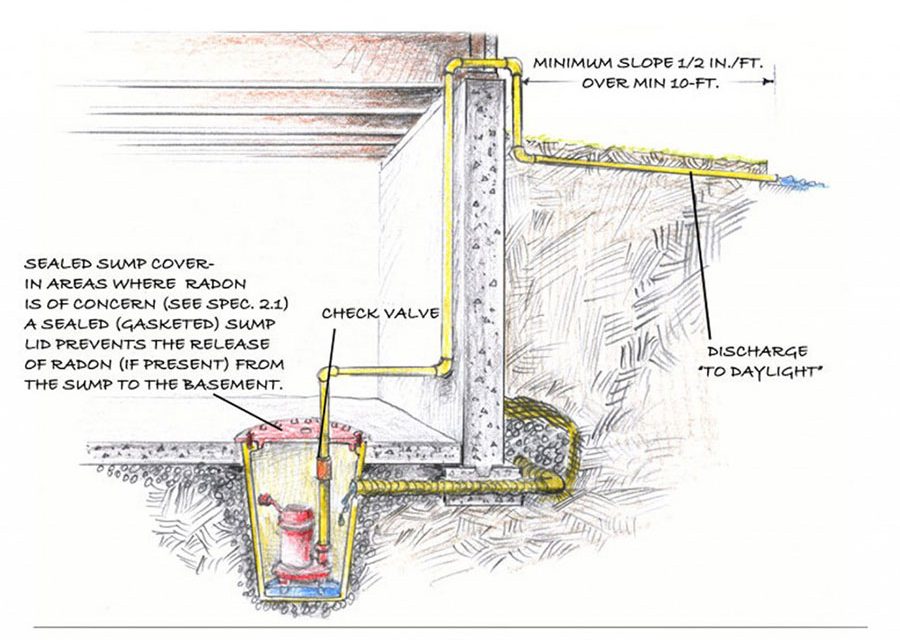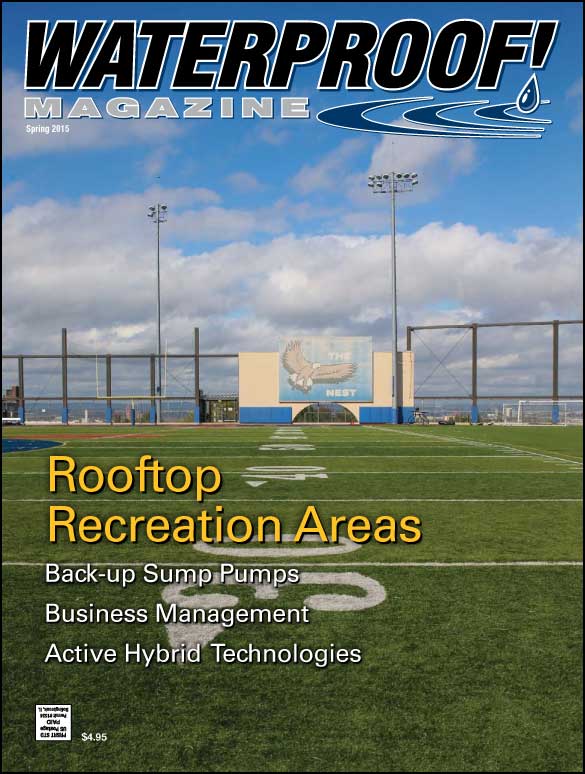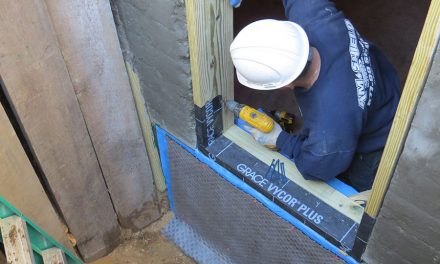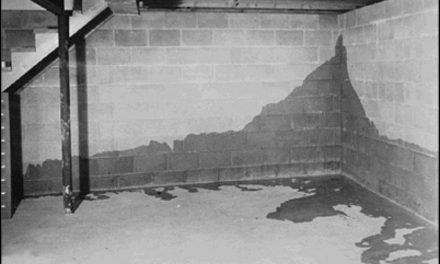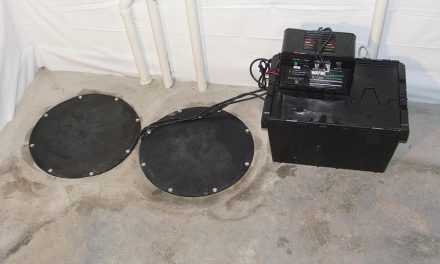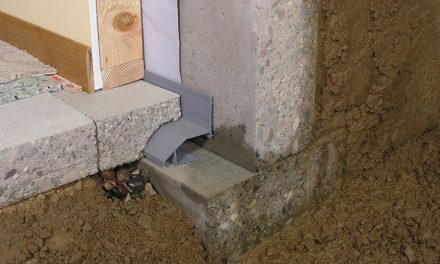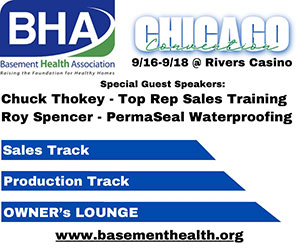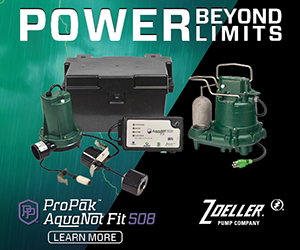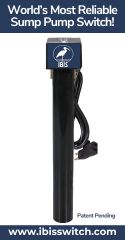Every Homeowner Should Consider this Basic Upgrade
By Blake Jeffery
Most homeowners understand that they have a primary sump pump in their basement to protect them from flooding. This main pump is usually hard-wired to the home’s electrical system for power. However, that’s not the end of the discussion. At some point one of the following situations will occur, rendering the primary pump inoperable, and putting the homeowner at risk for a flood:
- The power goes out
- The level control on the primary pump is obstructed or fails
- The primary pump fails due to some other mechanical problem
- The primary pump gets clogged with debris
This is why every home with a sump pump should have a reliable backup sump pump system for peace of mind when one of the above situations occurs. In addition to protecting valuable possessions and property, the best benefit of all is avoiding the frustration, aggravation, hours of cleanup time and money associated with a flood.
There are three basic types of backup sump pump systems available on the market, each with their own benefits.
- Battery Backup Sump Pump
- Water-Powered Backup Sump Pump
- Battery Backup Power Inverter
Each of these three systems will be described below providing insight as to what may provide the best solution for your home.
Battery Backup Sump Pump
A battery backup sump pump is not a battery hookup for your primary pump, but rather a separate sump pump system that is installed adjacent to your primary electric pump in the sump basin. It typically runs on 12-volt or 24-volt D/C battery power and can either be plumbed into the primary discharge pipe (the pipe hooked up to the sump pump to carry the water outside of the house) or can be installed with its own independent discharge pipe.
The battery backup sump pump has its own float switch so that when the water rises in the sump, it raises the float and the backup pump is activated. This is important for two reasons; (1) If the primary pump cannot keep up with the inflow due to excessive amounts of water entering the sump pit during an abnormal event, the backup pump will assist the primary pump in evacuating the water. (2) In the event of a power disruption or primary pump/level control failure, it will assume the role as the primary pump allowing time for the power to be restored or the A/C electric pump system to be serviced. When operating intermittently with a fully charged battery, most battery backup sump pump systems can provide pumping relief for days.

Some of the more advanced battery backup sump pump models incorporate unique monitoring systems that signal the homeowner with a visual and audio alarm when the following conditions exist:
- Fluid in the battery is low
- Battery terminals are corroded or the battery is defective
- Unit is not receiving A/C power
- Pump is defective or not connected
- Pump was activated
- High water alarms
- Pump failure detection
- Battery charging level
In addition, top-of-the-line battery backup sump pump systems will also include export terminals, so that the homeowner can connect the system to an auto-dialer. When connected to a home security system, it can be programmed to notify one or more contact phone numbers.
Water-Powered Backup Sump Pump
In areas where a pressurized municipal water supply is available (city water), a water-powered backup sump pump can be a reliable backup sump system without the need for a battery power supply. This type of system is designed to use the energy of flowing water through a venturi to create a low pressure region as the pressurized water moves through the device, which in turn allows atmospheric pressure to push water out of the sump pit and empty it.
The water-powered pump is installed in a sump pit, where a float will activate a valve to control the flow of pressurized municipal water. When the water level rises to a certain level, the valve will open. When the water lowers the valve is closed and the flow of water is stopped.

A water-powered backup sump pump is not intended to be used as a primary sump pump. It will require the use of municipal water for operation and is not as efficient as an A/C powered sump pump. A water-powered backup pump must use a separate discharge than your primary pump for two reasons. If the two pumps were to be tied together, a failure of the primary pump check valve would allow the municipal water to be pumped into the sump pit through the primary pump. Similarly, a failure in the incoming water pressure from municipal water supplies could allow sump water to enter into the municipal water and risk contamination.
Most water powered pumps suggest the use of a water backflow prevention device (called an RPZ valve) to protect potable water supplies. A water-powered sump pump is best used in conjunction with an alarm that will alert the user of a high water level or backup pump activity.

Please note that each municipality has their own requirements for backflow prevention in the water supply line. Make sure to contact your local water authority for information regarding the requirements for your area.
Inverter System Backup Sump Pump
A battery backup power inverter system offers many of the same advantages as the regular battery back-up systems discussed earlier. The difference is that the regular battery back-up pumps pull directly from the 12- or 24-volt D/C battery power. The inverter models convert the low-voltage D/C current into 120-volt A/C current which power the pump.
An inverter pump works off 120-volt A/C current, and has its own float switch so that when the water rises in the sump, it raises the float and the backup pump is activated. This allows the backup pump to assist the primary pump during abnormal events, and also take over as the primary pump in the event of a power disruption or primary pump/level control failure.

As with the other backup systems, under normal loads, an inverter system can provide pumping relief for days. They may also include the same monitoring systems that signal the homeowner with a visual and audio alarm and/or an auto-dialer when malfunctions are detected.
Sizing a Backup Sump Pump System
A pump system is generally chosen based upon the amount of water it can pump per hour or per minute at a certain height (head). Since sump pumps are installed lower than floor level in a sump pit, they will generally be required to pump around 10 feet high to exit the basement. By referring to the pump’s performance data, you will be able to determine the flow you can expect from the pump at a certain head. Note: a water-powered backup pump’s performance will depend on the head as well as the incoming water pressure.
In dry areas a pump with lower GPH (gallons per hour) or GPM (gallons per minute) will suffice. Those with a high water table, living in wetter areas, or with above average rainfall per year should choose a pump with more GPH or GPM.
Considerations
When choosing a battery backup sump pump system or inverter system that utilizes a battery, it is wise to choose a system that monitors the health of the battery and pump system and will audibly and visually alert the homeowner when maintenance is needed. This is very important in making sure that when your backup system sump is needed, it’s ready to pump and keep your basement dry.
Batteries should be inspected regularly to make sure their water levels are normal (when using batteries that have access to water levels) and the batteries are in good working condition. Not having a backup sump pump system can be like not having a sump pump at all.
When choosing a water-powered backup system it is important to ensure that a sustainable municipal water source with adequate pressure is available during the outage period. It is not recommended for houses served by private well pumps.
The Bottom Line
With volatile weather patterns, a backup sump pump system is more of a necessity than a luxury. All it takes is one storm that knocks out the power to put you at risk of a flood.
Is it worth it? A basement reconstruction can be daunting. The time involved for cleanup, plus the inconvenience and cost of having to replace things such as your furnace, water heater, washer and dryer, freezer, basement refrigerator, television, electronics, exercise equipment, cherished valuables that are often stored in the basement, etc. can quickly add up.
Given the choice of the above costs, plus time and aggravation versus the relatively low cost of installing a backup sump pump system, what makes the most sense?
The Sump and Sewage Pump Manufacturers Association recommends that a backup sump pump system always be installed for the extra protection. A list of manufacturers that offer this equipment, is available at the SSPMA website www.sspma.org/members.
Blake Jeffery is managing director for the Sump and Sewage Pump Manufacturers Association (SSPMA), a trade organization representing manufacturers of sump, effluent & sewage pumps, together with component and accessory suppliers. Find out more at www.SSPMA.org.
Spring 2015 Back Issue
$4.95
Active Hybrid Waterproofing Technologies
Back-up Sump Pump Systems
Rooftop Recreation Areas
AVAILABLE AS DIGITAL DOWNLOAD ONLY
Description
Description
Active Hybrid Waterproofing Technologies
By Stacy Byrd
This new non-curing, self-sealing technology makes it easier than ever to confidently waterproof difficult areas. It’s already been used on several landmark products.
Back-up Sump Pump Systems
By Blake Jeffery
Every home with a sump pump should have a reliable backup sump pump system to protect from problems such as power outages, switch malfunctions, and clogs.
Rooftop Recreation Areas
By Michael Popke
Pressed for space, campuses on both coasts have found room to expand their athletic fields by building stadiums on top of existing buildings. Obviously, waterproofing was a major concern.
Additional Info
Additional information
| Magazine Format | Digital Download Magazine, Print Mailed Magazine |
|---|

